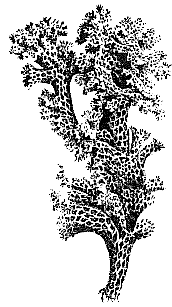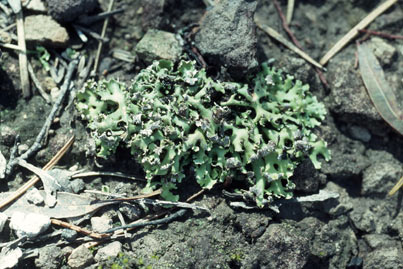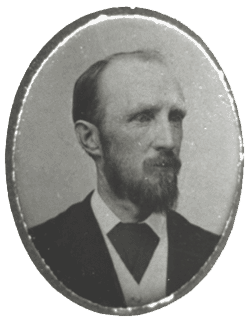|
Episodes in Australian lichenology
The first century
The first publication to mention an Australian lichen was the second volume of Jacques-Julien Houtou de Labillardière's Novae Hollandiae Plantarum Specimen, which appeared in 1806. Labillardière (1755-1834) had travelled with the Bruni D'Entrecasteaux expedition of 1791-1794 and had collected the specimens in question in Tasmania in 1792. In his 1806 monograph Labillardière described and illustrated a species he called Baeomyces reteporus. This is a lichen, though he classed it with the algae, and is now known by the name Cladia retipora ![]() . It was the only Australian lichen recorded by Labillardière and his specimens of this lichen are still held in Paris. Since then the species has been found in many parts of eastern Australia as well as in New Zealand and New Caledonia.
. It was the only Australian lichen recorded by Labillardière and his specimens of this lichen are still held in Paris. Since then the species has been found in many parts of eastern Australia as well as in New Zealand and New Caledonia.
The botanist Robert Brown (1773-1858) accompanied Matthew Flinders on his 1801-1803 voyage in HMS Investigator to chart the coast of Australia and Brown remained in Australia until 1805. Between 1801 and 1805 he collected several thousand plant specimens, including a number of lichens which are now held by the Natural History Museum in London. In a botanical appendix to Matthew Flinders' A Voyage to Terra Australis, published in 1814, Brown listed 58 lichen species which he said were common to Europe and Australia but he gave no information about where in Australia he'd found them. He published nothing else about Australian lichens and his collections were forgotten for much of the century. I'll say more about them a little later.
The year 1814 also saw the publication of Synopsis methodica lichenum, a fundamental lichen monograph by Erik Acharius (1757-1819), the 'father of lichenology'. In his Synopsis Acharius included Labillardière's lichen, but with a name change to Cenomyce retipora. Acharius mentioned another lichen, Collema tremelloides, noting that it was found in "Nova Hollandia" (as well as northern America) but gave no more precise information and the collector of the specimen is unknown. There has been some speculation as to whether the specimen was collected before Labillardière collected his. Another possibility is that a non-Australian collection was mistakenly labelled as Australian. While on the subject of early, mystery collections it's the appropriate time to mention the species originally published as Delisea pseudosticta in 1824 by Antoine Laurent Apollinaire Fée in Essai sur les cryptogames des écorces exotiques officinales. Fée never visited Australia, he does not state the collector's name and there is nothing about when it was collected. As to location, Fée wrote just "Nova Hollandia, île de King" - that is, "New Holland, King Island" and King Island is in Bass Strait.
In 1817 Charles Gaudichaud-Beaupré (1789-1854) travelled to the South Seas with the Freycinet expedition and collected four species of lichen from Australia - two from the Sydney area in New South Wales and two from Shark Bay in Western Australia. These lichens were examined by Christiaan Hendrik Persoon who found three of the four to have been previously unknown species. Gaudichaud-Beaupré included a report about the lichens in his botanical volume within the multivolume expedition report: Voyage autour du monde, exécuté sur les corvettes l'Uranie et la Physcienne. The botanical volume was published in 1826.
Between 1817 and 1831 Allan Cunningham (1791-1839) participated in various expeditions and botanized in many parts of Australia. Amongst his numerous botanical specimens were a number of lichens including Usnea scabrida![]() . The first description of this species was published by Thomas Taylor, in 1844, and was based on a specimen collected by Cunningham in the "interior of New South Wales". Taylor had been Professor of Botany at the Royal Cork Scientific Institute until 1830, when the government discontinued its grant to the Institute. Taylor then retired to his family estate but continued his studies of lichens and bryophytes
. The first description of this species was published by Thomas Taylor, in 1844, and was based on a specimen collected by Cunningham in the "interior of New South Wales". Taylor had been Professor of Botany at the Royal Cork Scientific Institute until 1830, when the government discontinued its grant to the Institute. Taylor then retired to his family estate but continued his studies of lichens and bryophytes![]() .
.
The first half of the 19th century saw several botanically-inclined travellers from German-speaking Europe visit Australia as parts of more extensive journeys. Franz Sieber (1789-1844) visited New South Wales in 1823 and collected lichens while there. A paper about Sieber's lichens was published in 1827 by Johann Friedrich Laurer, who described 11 new species from Sieber's Australian specimens. Karl von Hügel (1795-1870), a German lawyer/soldier turned natural historian, visited Australia during 1833-1834. He sent his lichens to the German lichenologist August von Krempelhuber (1813-1882), who reported 28 species in a paper published in 1868. Included in von Hügel's collections were two previously unknown species. Between late 1838 and 1842 Ludwig Preiss (1811-1883) collected lichens in south-west Western Australia. Elias Fries of Sweden studied the Preiss lichens and his conclusions appeared in Volume 2 of Plantae Preissiana, edited by Christian Lehmann. Of the 23 species mentioned, two were previously unknown. Fries also reported that one of the Preiss collections was Cladonia retipora. This was Fries' name for Labillardière's Baeomyces reteporus which, as noted earlier, was the first lichen reported from Australia, though Labillardière had found it in southern Tasmania. However, later research has shown that while there are similar species on both sides of Australia the species found by Labillardière in Tasmania does not occur in Western Australia. Another piece of information given by Lehmann for the Western Australian species was its Aboriginal name: Orgeck.
William James Hooker (1785-1865) and his son Joseph Dalton Hooker (1817-1911) were two of the major botanists of the 1800s. The elder Hooker became director of the Royal Botanic Gardens at Kew, in London, in 1841 and at his death was succeeded by his son, who remained director until 1885. William established a worldwide network of correspondents and collectors, so that in the mid 1800s numerous botanical specimens flowed into the Kew gardens from all parts of the world and the younger Hooker continued this network during his own term as director. Robert William Lawrence (1807-1833) was William Hooker's first significant Tasmanian correspondent. Lawrence, a man of leisure, was a keen student of natural history and sent Hooker numerous specimens, including many lichens. Lawrence introduced another Tasmanian, Ronald Campbell Gunn (1808-1881), to Hooker and after Lawrence's early death Gunn continued the association with Kew over several decades. Amongst the lichens Gunn sent to Hooker was Cladia retipora, though Hooker knew it by the name Cenomyce retipora. He wrote a short paper about the species noting that the specimens he had received allowed him to give more details than those supplied by Labillardière. Here are two of the illustrations that accompanied Hooker's paper, courtesy of the digital library of Missouri Botanical Garden.
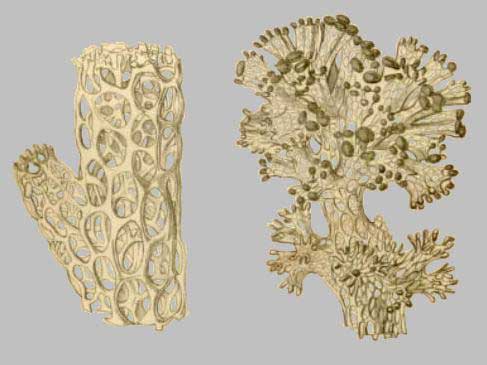
What Hooker saw, when he examined the specimens closely, induced him to make the sort of statement made by many when they have looked closely at the so-called 'lower' organisms such as the lichens:
Nothing in nature can exceed the elegant lace-like appearance of this plant, a structure one would little expect to meet with in the humblest and least perfect part, as it is usually considered, of the vegetable creation, the Lichens
.
William Hooker also established a productive, long-term association with James Drummond (1784-1863), a Scotsman who arrived in Western Australia in 1829 from Ireland where he had been curator of the Cork Botanical Gardens. He collected widely in south-western Western Australia and sent numerous specimens to the Hookers. While the bulk of Drummond's collections were of flowering plants he did send a good variety of bryophytes, lichens and other fungi. A paper published in 1846 described a new lichen genus, Thysanothecium, based on specimens that Drummond had sent to William Hooker. This is still recognized as a distinct genus today and was the first lichen genus to be described from material collected in Australia. You can read more in the THYSANOTHECIUM CASE STUDY. A little earlier on this web page I mentioned Thomas Taylor's description of the species Usnea scabrida. In that same paper Taylor noted that he had also received a specimen of that species from Drummond "from Swan River". In 1847 Taylor documented another 16 of Drummond's collections that had been sent to William Hooker. Of the 16 nine were described as new species that are still recognized as distinct species today, albeit now mostly placed in genera different to those assigned by Taylor. Here are the current names of the nine species (with Taylor's generic placements in brackets, where they differ from the modern placement): Acarospora citrina (Urceolaria), Caloplaca erythrosticta (Lecanora), Caloplaca lateritia (Lecidea), Lecidea multiflora, Paraporpidia glauca (Lecidea), Parmelina endoleuca (Parmelia), Psora crystallifera (Lecidea), Xanthoparmelia imitatrix (Parmelia) and Xanthoparmelia scabrosa (Parmelia). Some of the remaining seven collections had also been described as new species but later research has shown them to be identical to other species already known at the time![]() .
.
Joseph Hooker was a member of the scientific expedition that travelled through the southern oceans on the ships HMS Erebus and HMS Terror, under the overall command of James Clark Ross. In an 1840 letter to his father Joseph wrote that whilst on Kerguelen Island: "Many of my best little lichens were gathered by hammering at the tufts or sitting on them till they thawed". During the expedition Hooker spent a total of six weeks in Tasmania in 1840 and 1841 and visited Sydney for three in 1841. In Tasmania he undertook botanical collecting trips with Ronald Gunn. After his return to England Hooker sought the help of Thomas Taylor for a study of the lichens that had been collected during the Erebus & Terror voyage and in 1844 Hooker and Taylor published a paper about those lichens, recording 32 species from Tasmania. Amongst them was the first published description of Parmelia rutidota (now Flavoparmelia rutidota ![]() ). This species is very common on the bark of live trees and on dead wood in non-tropical Australia. In Canberra you can find this lichen on many trees within the Australian National Botanic Gardens and, elsewhere in the city, on numerous street trees and in the city's nature reserves. It may well be the commonest lichen found on dead wood in Australia and also occurs in the southern USA. In 1860 Hooker published his Flora Tasmaniae, an extensive monograph about the Tasmanian flora. This work utilised all the Tasmanian collections that Hooker had access to - collections made during the Erebus & Terror expedition as well as specimens that had been sent to Kew before and after the expedition by Gunn, Lawrence and many others. Taylor had died in 1848 and the Flora Tasmaniae's chapter about lichens was written by the Reverend Churchill Babington and William Mitten. They recorded 93 species, of which two were previously unknown. Babington was a classical scholar with wide interests (obviously including botany) and from 1865 to 1880 was a professor of archaeology at the University of Cambridge. Mitten was a pharmacist by trade but his botanical work (mostly with bryophytes) was of a high-calibre
). This species is very common on the bark of live trees and on dead wood in non-tropical Australia. In Canberra you can find this lichen on many trees within the Australian National Botanic Gardens and, elsewhere in the city, on numerous street trees and in the city's nature reserves. It may well be the commonest lichen found on dead wood in Australia and also occurs in the southern USA. In 1860 Hooker published his Flora Tasmaniae, an extensive monograph about the Tasmanian flora. This work utilised all the Tasmanian collections that Hooker had access to - collections made during the Erebus & Terror expedition as well as specimens that had been sent to Kew before and after the expedition by Gunn, Lawrence and many others. Taylor had died in 1848 and the Flora Tasmaniae's chapter about lichens was written by the Reverend Churchill Babington and William Mitten. They recorded 93 species, of which two were previously unknown. Babington was a classical scholar with wide interests (obviously including botany) and from 1865 to 1880 was a professor of archaeology at the University of Cambridge. Mitten was a pharmacist by trade but his botanical work (mostly with bryophytes) was of a high-calibre![]() .
.
Ferdinand Mueller arrived in Adelaide in 1848 and was appointed Victorian Government Botanist in 1853. He was a prodigious plant collector but also built up a network of correspondents and collectors in Australia. Mueller corresponded with Kew and some of the material Mueller sent to Kew was used by Babington and Mitten in their Flora Tasmaniae chapter. Mueller also sent lichens to continental European lichenologists and the first to receive specimens from Mueller was Ernst Georg Ludwig Hampe (1795-1880) in Germany. Later Mueller sent specimens to August von Krempelhuber and Jean Müller (1828-1896) of Geneva. Over the second half of the nineteenth century the publications of those three European lichenologists added considerably to the knowledge of Australian lichens. That was particularly the case with Jean Müller who re-examined and revised much of the earlier work on Australian lichens during the latter half of the 19th century. The first of Hampe's papers reporting on the lichens he received from Mueller appeared in 1852 and in it Hampe described the new species Sticta muelleri, which Hampe named in honour of Ferdinand Mueller. The description was based on a specimen collected by Mueller in the Mount Lofty Ranges near Adelaide. Today the species is known as Heterodea muelleri and it appears on the cover of the first of the lichen volumes in the Flora of Australia series. However the bulk of Hampe's paper was taken up by 36 lichens collected in Tasmania by Charles Stuart, who had met Mueller in Adelaide and sent Mueller many botanical collections. Ferdinand Mueller received specimens from several exploring expeditions. For example, Ludwig Leichardt collected a few lichens during his 1844-45 expedition from Queensland to Port Essington and these made their way to Krempelhuber via Ferdinand Mueller. Jean Müller published a paper about the 54 lichens collected by Richard Helms during the Elder Exploring Expedition to western South Australia and Western Australia in 1891-92. Helms had sent these to Ferdinand Mueller.
Between 1858 and 1869 William Nylander documented the 77 lichens collected by the French naturalist Jules Verreaux during his visit to Australia in the 1840s. Nylander (1822-1899) grew up in Finland, became a professor of botany at the University of Helsinki but in 1863 moved to Paris and lived there until his death. He published some important studies on the subject of LICHEN CHEMISTRY. From 1857 to 1859 the Austrian navy's frigate Novara circumnavigated the world with a party of scientific researchers. The expedition had been authorized by the Austrian archduke and much of the preparatory work was done by the academy of science in Vienna. The expedition stopped in Sydney in November-December of 1858 and during that time collected six species of lichens. An account of the expedition's botanical findings was published in 1870 under the title Reise der Österreichischen Fregatte Novara um die Erde in den Jahren 1857-1859 unter der Befehlen des Commodore B. von Wullerstorf-Urbair, Botanischer Theil, edited by Eduard Fenzl. The chapter about lichens was written by Krempelhuber.
The year 1867 saw the publication, in Sydney, of William Woolls' A contribution to the flora of Australia, a collection of chapters on various aspects of Australian botany, with one chapter headed Lichens. In the chapter's eleven pages Woolls, a schoolmaster with considerable interest in botany, added no new species but gave his readers descriptions of a small number of Australian lichens. Like various others before him Woolls was captivated by Cladia retipora and he thought it "the most interesting lichen I have seen in Australia". He also included a range of other observations, amongst which he noted that the genus Usnea, whatever it's utility in other respects "...there can be little doubt respecting its use to the bird stuffer, and as it is found in almost all countries, from the Arctic to the Antarctic regions, it is always available for collections of stuffed birds...". Woolls also thought that:
The Mosses, Lichens and Fungi, of Australia, though probably the vast majority of them may be cosmopolitan, have never received the attention which is necessary for attaining a correct estimate of their numbers, or for determining what species differ materially from those of the Northern Hemisphere.
The question of the relationships between the lichens of Australia and those of the rest of the world has continued to exercise the minds of lichenologists and the subject of LICHEN BIOGEOGRAPHY is still an active research area.
In 1880 the British lichenologist James Crombie published a paper about Robert Brown's long-neglected Australian lichen collection from early in the century. Crombie described these collections as "...valuable if not very extensive..." and also noted that:
As is unfortunately the case, both in the older and more recent collections of exotic lichens, no saxicole species are contained in Herb. R. Brown, though these would have very much added to its value and importance.
Crombie's paper recorded the majority of the collections as coming from Tasmania but there are some mistakes in the published locations. For example, according to the paper Robert Brown collected Parmelia australiensis (now Xanthoparmelia australiensis) and Chondropsis semiviridis (now Xanthoparmelia semiviridis) from "Table Mt.", Brown's name for Mount Wellington. Neither species has been found in Tasmania since Brown's time but both are known from the generally drier areas of mainland Australia. The Chondropsis is very widespread while the Parmelia has been found in the Flinders Ranges of South Australia and on the Nullarbor. Most likely Brown collected both species in South Australia and, at some stage between collection and publication, there was a mix-up. Crombie listed 73 species, including 12 that were new to science and the descriptions of some of these were provided by William Nylander. One of the new species described by Nylander, Ramalodium succulentum, was also the basis for a new genus. The latter half of the 20th century has seen an additional five species added to the genus Ramalodium but Ramalodium succulentum is still the only species of the genus known from Australia and, since Robert Brown's time, no additional specimens of that species have been found. Crombie noted that though Brown had published no catalogue of the lichens he'd collected, it was clear that he had intended to do so, given his notes about some of the specimens he'd collected. Indeed, such were the notes made by Brown that, for a couple of the new species in this paper, the descriptions were Brown's![]() .
.
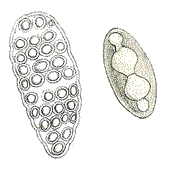 In 1881 the New Zealand surgeon Charles Knight visited Australia and collected lichens in the Sydney area. He published a paper about these in 1882 and in the introduction wrote that he "...was led to make the collections on receiving the interesting paper of the Rev. Mr. Crombie on the Australasian [sic] Lichens in Robert Brown's Herbarium". Knight's paper documented 52 species, a great many of which he described as new and illustrated both the macroscopic appearance as well as the spores and asci of all the "new or interesting" species
In 1881 the New Zealand surgeon Charles Knight visited Australia and collected lichens in the Sydney area. He published a paper about these in 1882 and in the introduction wrote that he "...was led to make the collections on receiving the interesting paper of the Rev. Mr. Crombie on the Australasian [sic] Lichens in Robert Brown's Herbarium". Knight's paper documented 52 species, a great many of which he described as new and illustrated both the macroscopic appearance as well as the spores and asci of all the "new or interesting" species![]() .
.
Frederick Manson Bailey (1827-1915) was appointed Queensland Colonial Botanist in 1881 and remained the government botanist until his death. He undertook numerous botanical expeditions and also received botanical specimens from various correspondents. Bailey sent the lichens he collected or received to overseas lichenologists for identification - in particular Charles Knight and James Stirton (in Glasgow). Stirton was another of the very able amateur lichenologists of the 1800s. He was medically trained and in the late 1800s held appointments as lecturer in gynaecology and professor of midwifery. Stirton received specimens from people in various parts of Australia and in the 1880s and 1890s published descriptions of many Australian lichens. In 1883 Bailey published a Synopsis of the Queensland Flora in which he included the lichen species that had been reported to occur in Queensland. Three Synopsis supplements appeared in 1886, 1888 and 1890 and all reported additional lichens for the state. The first supplement included many new species with descriptions provided by Knight and two pages of Knight's black-and-white drawings that showed the features of 27 species. Bailey's Comprehensive catalogue of Queensland plants of 1909 listed the state's known lichens and the book included black-and-white illustrations of a number of species. Those illustrations were fairly simplistic and mostly adaptations of diagrams from other sources.
John Francis Shirley (1849-1922) had studied under Thomas Huxley in England and in 1878 migrated to Queensland where he spent much of his working life as an inspector of schools. He had wide interests in natural history and his travels as a school inspector (reportedly 6500-8000 kilometres annually) allowed him to indulge these interests in many parts of the state. Shirley sent lichens to Charles Knight, Jean Müller and James Stirton. Shirley did much to increase knowledge about Queensland's lichens and, from 1888, published several detailed papers about the state's lichens. His interests extended beyond Queensland and he also published some papers dealing with Tasmanian and Victorian lichens. In 1912, when Shirley was aged 63, the University of Sydney awarded Shirley the degree of Doctor of Science, based on an examination and the submission of a thesis titled The Thallus of the genus Parmelia. As far as I know this was the first higher degree on lichen work to be awarded in Australia. You can read more in the SHIRLEY'S THESIS CASE STUDY.
The Reverend Francis Robert Muter Wilson (1832-1903) was a minister of the Presbyterian Church in Victoria, first in the country at Camperdown and later, from 1877 to 1897, at Kew within Melbourne. Wilson had become quite ill by the end of 1883 and was granted nine months leave to help his recovery. During this time Wilson returned to his native Scotland and while there an unknown friend suggested that Wilson collect Victorian lichens for they had not been well studied. Wilson began his lichenological work by collecting specimens before he began his return journey to Australia and, on his return journey, also collected during a short coaling stop at the Indian Ocean island of Diego Garcia. Wilson wrote a short account of his hour on the island and here is what he said about the lichens:
Lichens, however, are what I am after. And there they are! What a beautiful one on that tree - the colour a splendid greenish blue, the shape circular, and about 6 in. in diameter. How regularly the narrow divisions of the thallus are arranged! And the black apothecia scattered around the centre add to the beauty of the plant. It is evidently a Physcia. I select one or two smaller specimens, and, taking out my knife, cut off the lichens along with the very thick bark of the tree, and wrap them up in newspaper, with which I came plentifully supplied. I come out of the deep shade and find another, apparently the same Physcia, but it is white, doubtless from the action of the sun. However, I cannot stop to examine closely. Hah! what is it that gives such vivid colours to the stems of those cocoanut [sic] trees? - yellow and orange, rich brown and snowy white. Lichens, I see; and apparently Verrucarias. Here are some Graphidea; and there are other forms new to me. I get excited, I collect largely of each kind, pushing on through the grove of cocoanuts, but keeping my eye on the direction I am going; for I have not been a traveller in the Australian bush without learning prudence...The hour has flown by far too rapidly, and with regret I return to the ship, leaving many species of lichen ungathered..
.
After his return Wilson collected numerous lichen specimens from many areas of eastern Australia and also from several Pacific islands. The first person from whom Wilson had sought advice was Charles Knight and in 1890 began a correspondence with Jean Müller to whom he sent many specimens. John Shirley was another of Wilson's correspondents. Wilson had helped Shirley with some lichen identifications and the two exchanged specimens. Between 1887 and 1900 Wilson published 22 papers on the subject of Australian and non-Australian lichens. His final paper dealt with the lichens collected by Robert Hall on Kerguelen Island and lodged at the Melbourne herbarium. This was published in the French journal Memoires de l'Herbier Boissier. The herbarium at the Royal Botanic Gardens in Melbourne received a major part of the lichens Wilson had collected but he had also sold about 20,000 specimens to the New South Wales government and these are still housed at the herbarium of the Royal Botanic Gardens in Sydney. By late 1907 the Melbourne herbarium's holdings of Wilson's lichen collections had been sent for study to Giocomo Albo of the University of Messina, Sicily. They were sent in two consignments, the first of which arrived safely. In a letter of 10 September 1907 to Albo, Alfred Ewart, the Victorian Government Botanist wrote:
The material already sent was accumulated by the late Rev. Wilson during his later years, and was included in the collection purchased from his Widow after his death. I am now sending you the whole of his collection, named and unnamed, so that full comparison will be possible. The material you have already received has not been worked on by anyone else, and the whole is probably the most complete collection of Australian Lichens extant, although the Sydney Herbarium has a fine set.
However, the second consignment never arrived in Sicily and nothing is known of its fate. A number of specimens that Albo had received did make their way back to Melbourne and the Sydney herbarium still has its large Wilson collection, which would have contained duplicates of many of the specimens which Melbourne had received. Nevertheless, the disappearance of that second consignment was a significant loss to Australian lichenology![]() .
.
|
Richard Austin Bastow (1840-1920), Wilson's contemporary and, from 1888, also a resident of Melbourne, was an active natural historian. Through the Field Naturalists Club of Victoria (FNCV) Bastow met Wilson and the two became good friends. They made many joint field excursions and Bastow published one paper about Victoria's lichens. Before moving to Melbourne Bastow had lived in Tasmania where, along with William Anderson Weymouth (1841-1928), he had spent much time studying bryophytes and lichens, though during his Tasmanian days Bastow had published only about the Tasmanian bryophytes. In the February 1914 issue of The Victorian Naturalist (the FNCV journal) Bastow published Notes on the lichen-flora of Victoria, in which he briefly described the characteristics of the lichen genera found in Victoria. This was intended to help lichen enthusiasts recognize genera. As with Bastow, Weymouth's major contribution to Tasmanian botany was his bryological work but he did send lichens to overseas experts. One of these was the Italian Antonio Jatta (1853-1912) who, apart from botanical work, also had archaeological interests and served as a senator in the Italian parliament. Jatta devoted a 1911 paper to documenting the specimens Weymouth had sent.
In 1903 Edwin Cheel (1872-1951) published his Bibliography of Australian lichens and in 1906 supplemented that with a Bibliography of Australian, New Zealand and South Sea Island lichens. Both appeared as papers in the journal Papers and Proceedings of the Royal Society of New South Wales and both were very useful publications. Australian lichens had been documented in such a variety of Australian and overseas journals or books that, without a good bibliography, it could be very difficult for anyone to find out what publications there were about Australian lichens.
A century of study of Australian lichens had shown that this continent possessed species quite different to those elsewhere in the world as well as species similar to or even the same as those in other parts of the world. Papers published by several European lichenologists were beginning to show how the Australian lichen flora was related to the lichen floras in other parts of the world. By the end of the century resident Australian lichenologists such as Wilson and Shirley were working assiduously and making their findings available in various Australian journals. It would have seemed likely that, on the basis of such a good foundation, work on Australian lichens would have continued fairly steadily. Yet, there was a hiatus, with little additional study of Australian lichens for several decades and the further history is continued in the SECOND CENTURY page.
History of Australian lichenology pages on this website |
![An Australian Government Initiative [logo]](/images/austgovt_brown_90px.gif)


